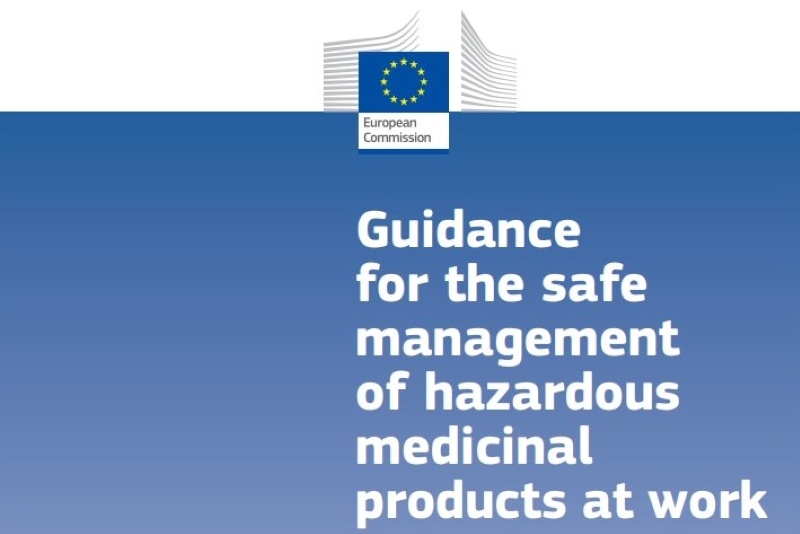
EU Commission: Guidance on reducing workers' exposure to dangerous medicines
A guide has been published by the European Commission providing practical examples to reduce workers’ exposure to dangerous medicines at all stages of their cycle: production, transport and storage, preparation, administration to patients (human and animal) and waste management
The guide offers practical advice
It is aimed at practitioners, employers, public authorities and safety experts to support their approaches to protecting workers from potentially dangerous medicines.
Hazardous medicines are defined as those containing one or more substances that meet the criteria for classification as: Carcinogenic (category 1A or 1B); Mutagenic (category 1A or 1B); Reproductive Toxic 1 (category 1A or 1B).
Hazardous drugs may cause undesirable effects in persons other than patients themselves, such as exposed workers
And they may have carcinogenic, mutagenic or reprotoxic effects.
For example, some cause cancer or developmental changes such as foetal loss and possible malformations in offspring, infertility and low birth weight.
The guide reports estimates from the COWI study (2021) that 54 cases of breast cancer and 13 cases of haematopoietic cancer in 2020 can be attributed to occupational exposure to hazardous drugs in EU hospitals and clinics.
The COWI study (2021) attributes an additional 1,287 miscarriages per year in 2020, rising to 2,189 miscarriages per year in 2070, to occupational exposure to hazardous drugs in EU hospitals and clinics.
The COWI (2021) study estimates that nearly 1.8 million workers are exposed to hazardous drugs today, 88% of whom are employed in hospitals, clinics and pharmacies.
COWI (2021) also estimates that the proportion of female workers in the occupational groups concerned ranges from 4% (technical staff in waste and waste water treatment) to 92% (carers, caregivers and veterinarians).
The aim of the Guide is to increase awareness of the risks of hazardous medicines among workers who may come into contact with them and their employers
Other aims are to increase good practice among workers dealing with these substances across the EU and to provide a useful reference point and support for training activities; to improve the flow of information during the transition between different stages of the life cycle in their supply chain; and to promote harmonisation between Member States and sectors by ensuring that all stakeholders have comprehensive guidance.
There are some existing guides covering the use of HMPs, but they are often written at regional or local level, or cover only parts of the life cycle or specific roles.
This guide should reduce the fragmentation of guidance on hazardous drugs; be a flexible and up-to-date tool that can be revised in the future, responding and adapting to pharmaceutical advances
The guide focuses on the prevention and control of risks from occupational exposure, and the information it contains is not a comprehensive overview of procedures to ensure patient safety.
The information in this guide should be read in conjunction with legislation and protocols to ensure patient safety.
The guide is divided into sections on general and specific topics
The first seven sections and section 13 on incident management are general and apply to all phases of the life cycle.
Sections 8 to 12 and 14 to 15 cover every phase of the life cycle of hazardous drugs, from production to waste.
There are several annexes providing glossary, additional information and examples of risk assessment templates and summary sheets.
The guide aims to provide an overview of available good practices and provide practical ways to reduce workers’ exposure to hazardous drugs.
It is designed for all types of organisations, regardless of size, both public and private, and at all stages of the HPP life cycle.
It also applies to facilities participating in clinical trials.
It is a non-binding guide intended to be used by Member States, regional and local organisations to support their approaches to protecting workers from HPPs.
It is based on existing European legislation and the guidance is without prejudice to applicable European or national provisions.
The guide provides relevant advice to national authorities, employers and workers and is useful for anyone with a range of responsibilities
e.g. occupational health and safety experts; those responsible for training in the safe handling of hazardous drugs at work; nurses and other healthcare professionals working in other departments such as intensive care, recovery and palliative care, which patients may visit after administering a hazardous drug; workers’ representatives etc.
The guide is designed for workers who come into contact with hazardous drugs and not for patients, their families, or informal carers (people who are not workers in an employment relationship with a healthcare employer).
The guide compiled by the EU
guidance-hmp_final-CRead Also
Emergency Live Even More…Live: Download The New Free App Of Your Newspaper For IOS And Android
Symptoms And Foods To Avoid With Nickel Allergy
When Can We Talk About Occupational Allergies?
Adverse Drug Reactions: What They Are And How To Manage Adverse Effects
Occupational Diseases: Sick Building Syndrome, Air Conditioning Lung, Dehumidifier Fever
Symptoms Of Asthma Attack And First Aid To Sufferers
Occupational Asthma: Causes, Symptoms, Diagnosis And Treatment
Extrinsic, Intrinsic, Occupational, Stable Bronchial Asthma: Causes, Symptoms, Treatment
Firefighters’ Risk Of Irregular Heartbeat Linked To Number Of On-The-Job Fire Exposures


